Unmounted Absorptive Neutral Density Filters

- Optical Densities from 0.1 to 8.0
- Attenuate Visible Light
- Ø1/2", Ø25 mm, Ø2", and 2" x 2" Sizes Available
NE260B
(2" x 2")
NE2R30B
(Ø2")
NE03B
(Ø25 mm)
NE505B
(Ø1/2")
NE201B in an FH2
Fixed Filter Mount
(See Link to Right)

Please Wait
| Neutral Density Filter Selection Guide |
|
|---|---|
| Absorptive | |
| Uncoated (400 - 650 nm) |
Mounted |
| Unmounted | |
| Uncoated (1000 - 2600 nm) |
Mounted |
| Unmounted | |
| AR Coated (350 - 700 nm) |
Mounted |
| Unmounted | |
| AR Coated (650 - 1050 nm) |
Mounted |
| Unmounted | |
| AR Coated (1050 - 1700 nm) |
Mounted |
| Unmounted | |
| Variable | |
| Reflective | |
| UV Fused Silica (200 - 1200 nm) |
Mounted |
| Unmounted | |
| N-BK7 (350 - 1100 nm) |
Mounted |
| Unmounted | |
| ZnSe (2 - 16 µm) |
Mounted |
| Unmounted | |
| Wedged UVFS (200 - 1200 nm) | |
| Wedged N-BK7 (350 - 1100 nm) | |
| Wedged ZnSe (2 - 16 µm) | |
| Variable | |
| Neutral Density Filter Kits | |
Features
- Four Sizes Available:
- Ø1/2"
- Ø25 mm
- Ø2"
- 2" x 2"
- Optical Densities
- 0.1 to 6.0 for Ø1/2", Ø2", and 2" x 2" Filter Options
- 0.1 to 8.0 for Ø25 mm Filters
- Ideal for Low-Power Applications (<1 W, see the Specs Tab for Additional Details)
- Absorptive Glass Reduces Multiple Reflections
Our absorptive neutral density (ND) filters are available in four sizes with optical densities (OD) ranging from 0.1 to 8.0. Unlike their reflective, metallic counterparts, each ND filter is fabricated from a Schott glass substrate that has been selected for its spectrally flat absorption coefficient in the visible region from 400 nm to 650 nm. By varying the type and thickness of the glass used, we are able to produce the entire line of absorptive ND filters from just four types of Schott glass. Due to the variations between different lots of glass, Thorlabs recommends that each filter be calibrated in the user's setup before taking quantitative measurements. The Specs tab contains the typical transmission and damage threshold of each filter type, while the Graphs tab contains transmission and reflectivity curves for the 300 - 1100 nm wavelength range.
For each filter size option available, Thorlabs also offers a filter kit option at the bottom of this page. Each kit contains a selection of 10-12 of the most popular absorptive neutral density filters for that size. A lockable metal case with a foam insert for storing loose square filters is also available below.
The round unmounted filters listed on this page are directly compatible with our lens tubes. Alternatively, filters can be purchased premounted in SM-threaded mounts that are engraved with the optical density and part number. Although the 2" x 2" neutral density filters are only offered unmounted, they are directly compatible with Thorlabs' family of fixed filter mounts.
The filters sold on this page are uncoated. For our full selection of coated and uncoated ND filters, please see the Selection Guide table on the right.
Optical Density and Transmission
Optical density (OD) indicates the attenuation factor provided by an optical filter, i.e. how much it reduces the optical power of an incident beam. OD is related to the transmission, T, by the equation

where T is a value between 0 and 1. Choosing an ND filter with a higher optical density will translate to lower transmission and greater absorption of the incident light. For higher transmission and less absorption, a lower optical density would be appropriate. As an example, if a filter with an OD of 2 results in a transmission value of 0.01, this means the filter attenuates the beam to 1% of the incident power. Please note that the transmission data for our neutral density filters is provided in percent (%).
Please note that these products are not designed for use as laser safety equipment. For lab safety, Thorlabs offers an extensive line of safety and blackout products, including beam blocks, that significantly reduce exposure to stray light.
| Filter Sizes | Ø1/2" | Ø25 mm | Ø2" | 2" x 2" |
|---|---|---|---|---|
| Dimensional Tolerance | +0.0 / -0.25 mm (Diameter) | +0.0 / -0.25 mm (H, L) | ||
| Clear Aperture | >Ø11.4 mm | >Ø20.0 mm | >Ø45.7 mm | >45.7 x 45.7 mm |
| Surface Quality | 40-20 Scratch-Dig | |||
| Parallelism | <10 arcsec | |||
| Substrate | NG1, NG4, NG9, or NG11 (Schott Glass) | |||
| For OD < 1.3 | ||||
| Transmitted Wavefront Error (TWE) | <λ/4 (@ 633 nm) | <λ/4 (@ 633 nm) | <λ (@ 633 nm) | <2λ (@ 633 nm) |
| For OD ≥ 1.3 | ||||
| Surface Flatness | <λ/4 (@ 633 nm) | - | <λ (@ 633 nm) | <2λ (OD = 1.3, 1.5) 2λ (OD = 2, 3, 4, 5, 6) (@ 633 nm) |
| Transmitted Wavefront Error (TWE) | - | <λ/4 (@ 633 nm) |
- | - |
| Damage Threshold Specifications | ||
|---|---|---|
| Optical Density | Damage Threshold | |
| 0.2 | Pulsed | 10 J/cm2 (532 nm, 10 ns, 10 Hz, Ø0.456 mm) |
| 0.3 | CWa | 25 W/cm (532 nm, Ø1.0 mm) |
| 1.0 | CWa | 12 W/cm (532 nm, Ø1.0 mm) |
| Pulsed | 10 J/cm2 (532 nm, 10 ns, 10 Hz, Ø0.504 mm) | |
| 2.0 | CWa,b | 12 W/cm (532 nm, Ø1.0 mm) |
| Pulsed | 10 J/cm2 (532 nm, 10 ns, 10 Hz, Ø0.390 mm) | |
| 4.0 | CWa | 10 W/cm (532 nm, Ø1.0 mm) |
| Pulsed | 5 J/cm2 (532 nm, 10 ns, 10 Hz, Ø0.340 mm) | |
| 6.0 | Pulsed | 5 J/cm2 (532 nm, 10 ns, 10 Hz, Ø0.340 mm) |
| Optical Density (@ 633 nm) |
Theoretical Transmissiona (@ 633 nm) |
Substrate Thicknessb | Substrate |
|---|---|---|---|
| 0.1 ± 0.01 | 77.6 to 81.3% | 0.6 mm | NG11 |
| 0.2 ± 0.01 | 61.7 to 64.6% | 1.4 mm | NG11 |
| 0.3 ± 0.015 | 50% | 2.3 mm | NG11 |
| 0.4 ± 0.02 | 40% | 0.7 mm | NG4 |
| 0.5 ± 0.025 | 32% | 0.9 mm | NG4 |
| 0.6 ± 0.03 | 25% | 1.1 mm | NG4 |
| 0.7 ± 0.035 | 20% | 1.3 mm | NG4 |
| 0.8 ± 0.04 | 16% | 1.5 mm | NG4 |
| 0.9 ± 0.045 | 13% | 1.7 mm | NG4 |
| 1.0 ± 0.05 | 10% | 1.9 mm | NG4 |
| 1.3 ± 0.065 | 5% | 2.5 mm | NG4 |
| 1.5 ± 0.075 | 3% | 2.9 mm | NG4 |
| 2.0 ± 0.10 | 1% | 1.4 mm | NG9 |
| 3.0 ± 0.15 | 0.1% | 2.1 mm | NG9 |
| 4.0 ± 0.20 | 1.0x10-2% | 2.8 mm | NG9 |
| 5.0 ± 0.25 | 1.0x10-3% | 3.6 mm | NG9 |
| 6.0 ± 0.30 | 1.0x10-4% | 1.5 mm | NG1 |
| 7.0 ± 0.35 | 1.0x10-5% | 1.7 mm | NG1 |
| 8.0 ± 0.40 | 1.0x10-6% | 1.9 mm | NG1 |
Optical Density
Optical density (OD) indicates the attenuation factor provided by an optical filter, i.e. how much it reduces the optical power of an incident beam. OD is related to the transmission, T, by the equation

where T is a value between 0 and 1. Choosing an ND filter with a higher optical density will translate to lower transmission and greater absorption of the incident light. For higher transmission and less absorption, a lower optical density would be appropriate. As an example, if a filter with an OD of 2 results in a transmission value of 0.01, this means the filter attenuates the beam to 1% of the incident power. Please note that the transmission data for our neutral density filters is provided in percent (%).
| For Detailed Plot Information | |
|---|---|
| Please use the icon shown to the left in the product listings for plots of the wavelength-dependent transmission (and optical density) for each filter type. Excel files containing the raw data used to make these plots are also available for download. | |
| Optical Density | Transmission Raw Data files are available for each part by clicking on the blue "info icons" in the tables in the pricing area. |
Reflectance An Excel file with 8° AOI reflectance data is also available. |
|---|---|---|
| OD 0.1 - 0.5 | ||
| OD 0.6 - 0.9 | ||
| OD 1.0 - 2.0 | ||
| OD 3.0 - 4.0 | ||
| OD 5.0 - 6.0 | ||
| OD 7.0 - 8.0 |
| Damage Threshold Specifications | ||
|---|---|---|
| Optical Density | Damage Threshold | |
| 0.2 | Pulsed | 10 J/cm2 (532 nm, 10 ns, 10 Hz, Ø0.456 mm) |
| 0.3 | CWa | 25 W/cm (532 nm, Ø1.0 mm) |
| 1.0 | CWa | 12 W/cm (532 nm, Ø1.0 mm) |
| Pulsed | 10 J/cm2 (532 nm, 10 ns, 10 Hz, Ø0.504 mm) | |
| 2.0 | CWa,b | 12 W/cm (532 nm, Ø1.0 mm) |
| Pulsed | 10 J/cm2 (532 nm, 10 ns, 10 Hz, Ø0.390 mm) | |
| 4.0 | CWa | 10 W/cm (532 nm, Ø1.0 mm) |
| Pulsed | 5 J/cm2 (532 nm, 10 ns, 10 Hz, Ø0.340 mm) | |
| 6.0 | Pulsed | 5 J/cm2 (532 nm, 10 ns, 10 Hz, Ø0.340 mm) |
Damage Threshold Data for Thorlabs' Absorptive ND Filters
The specifications to the right are measured data for Thorlabs' absorptive neutral density filters. Damage threshold specifications are constant for a given optical density, regardless of the size of the filter.
Laser Induced Damage Threshold Tutorial
The following is a general overview of how laser induced damage thresholds are measured and how the values may be utilized in determining the appropriateness of an optic for a given application. When choosing optics, it is important to understand the Laser Induced Damage Threshold (LIDT) of the optics being used. The LIDT for an optic greatly depends on the type of laser you are using. Continuous wave (CW) lasers typically cause damage from thermal effects (absorption either in the coating or in the substrate). Pulsed lasers, on the other hand, often strip electrons from the lattice structure of an optic before causing thermal damage. Note that the guideline presented here assumes room temperature operation and optics in new condition (i.e., within scratch-dig spec, surface free of contamination, etc.). Because dust or other particles on the surface of an optic can cause damage at lower thresholds, we recommend keeping surfaces clean and free of debris. For more information on cleaning optics, please see our Optics Cleaning tutorial.
Testing Method
Thorlabs' LIDT testing is done in compliance with ISO/DIS 11254 and ISO 21254 specifications.
First, a low-power/energy beam is directed to the optic under test. The optic is exposed in 10 locations to this laser beam for 30 seconds (CW) or for a number of pulses (pulse repetition frequency specified). After exposure, the optic is examined by a microscope (~100X magnification) for any visible damage. The number of locations that are damaged at a particular power/energy level is recorded. Next, the power/energy is either increased or decreased and the optic is exposed at 10 new locations. This process is repeated until damage is observed. The damage threshold is then assigned to be the highest power/energy that the optic can withstand without causing damage. A histogram such as that below represents the testing of one BB1-E02 mirror.

The photograph above is a protected aluminum-coated mirror after LIDT testing. In this particular test, it handled 0.43 J/cm2 (1064 nm, 10 ns pulse, 10 Hz, Ø1.000 mm) before damage.

| Example Test Data | |||
|---|---|---|---|
| Fluence | # of Tested Locations | Locations with Damage | Locations Without Damage |
| 1.50 J/cm2 | 10 | 0 | 10 |
| 1.75 J/cm2 | 10 | 0 | 10 |
| 2.00 J/cm2 | 10 | 0 | 10 |
| 2.25 J/cm2 | 10 | 1 | 9 |
| 3.00 J/cm2 | 10 | 1 | 9 |
| 5.00 J/cm2 | 10 | 9 | 1 |
According to the test, the damage threshold of the mirror was 2.00 J/cm2 (532 nm, 10 ns pulse, 10 Hz, Ø0.803 mm). Please keep in mind that these tests are performed on clean optics, as dirt and contamination can significantly lower the damage threshold of a component. While the test results are only representative of one coating run, Thorlabs specifies damage threshold values that account for coating variances.
Continuous Wave and Long-Pulse Lasers
When an optic is damaged by a continuous wave (CW) laser, it is usually due to the melting of the surface as a result of absorbing the laser's energy or damage to the optical coating (antireflection) [1]. Pulsed lasers with pulse lengths longer than 1 µs can be treated as CW lasers for LIDT discussions.
When pulse lengths are between 1 ns and 1 µs, laser-induced damage can occur either because of absorption or a dielectric breakdown (therefore, a user must check both CW and pulsed LIDT). Absorption is either due to an intrinsic property of the optic or due to surface irregularities; thus LIDT values are only valid for optics meeting or exceeding the surface quality specifications given by a manufacturer. While many optics can handle high power CW lasers, cemented (e.g., achromatic doublets) or highly absorptive (e.g., ND filters) optics tend to have lower CW damage thresholds. These lower thresholds are due to absorption or scattering in the cement or metal coating.

LIDT in linear power density vs. pulse length and spot size. For long pulses to CW, linear power density becomes a constant with spot size. This graph was obtained from [1].

Pulsed lasers with high pulse repetition frequencies (PRF) may behave similarly to CW beams. Unfortunately, this is highly dependent on factors such as absorption and thermal diffusivity, so there is no reliable method for determining when a high PRF laser will damage an optic due to thermal effects. For beams with a high PRF both the average and peak powers must be compared to the equivalent CW power. Additionally, for highly transparent materials, there is little to no drop in the LIDT with increasing PRF.
In order to use the specified CW damage threshold of an optic, it is necessary to know the following:
- Wavelength of your laser
- Beam diameter of your beam (1/e2)
- Approximate intensity profile of your beam (e.g., Gaussian)
- Linear power density of your beam (total power divided by 1/e2 beam diameter)
Thorlabs expresses LIDT for CW lasers as a linear power density measured in W/cm. In this regime, the LIDT given as a linear power density can be applied to any beam diameter; one does not need to compute an adjusted LIDT to adjust for changes in spot size, as demonstrated by the graph to the right. Average linear power density can be calculated using the equation below.

The calculation above assumes a uniform beam intensity profile. You must now consider hotspots in the beam or other non-uniform intensity profiles and roughly calculate a maximum power density. For reference, a Gaussian beam typically has a maximum power density that is twice that of the uniform beam (see lower right).
Now compare the maximum power density to that which is specified as the LIDT for the optic. If the optic was tested at a wavelength other than your operating wavelength, the damage threshold must be scaled appropriately. A good rule of thumb is that the damage threshold has a linear relationship with wavelength such that as you move to shorter wavelengths, the damage threshold decreases (i.e., a LIDT of 10 W/cm at 1310 nm scales to 5 W/cm at 655 nm):

While this rule of thumb provides a general trend, it is not a quantitative analysis of LIDT vs wavelength. In CW applications, for instance, damage scales more strongly with absorption in the coating and substrate, which does not necessarily scale well with wavelength. While the above procedure provides a good rule of thumb for LIDT values, please contact Tech Support if your wavelength is different from the specified LIDT wavelength. If your power density is less than the adjusted LIDT of the optic, then the optic should work for your application.
Please note that we have a buffer built in between the specified damage thresholds online and the tests which we have done, which accommodates variation between batches. Upon request, we can provide individual test information and a testing certificate. The damage analysis will be carried out on a similar optic (customer's optic will not be damaged). Testing may result in additional costs or lead times. Contact Tech Support for more information.
Pulsed Lasers
As previously stated, pulsed lasers typically induce a different type of damage to the optic than CW lasers. Pulsed lasers often do not heat the optic enough to damage it; instead, pulsed lasers produce strong electric fields capable of inducing dielectric breakdown in the material. Unfortunately, it can be very difficult to compare the LIDT specification of an optic to your laser. There are multiple regimes in which a pulsed laser can damage an optic and this is based on the laser's pulse length. The highlighted columns in the table below outline the relevant pulse lengths for our specified LIDT values.
Pulses shorter than 10-9 s cannot be compared to our specified LIDT values with much reliability. In this ultra-short-pulse regime various mechanics, such as multiphoton-avalanche ionization, take over as the predominate damage mechanism [2]. In contrast, pulses between 10-7 s and 10-4 s may cause damage to an optic either because of dielectric breakdown or thermal effects. This means that both CW and pulsed damage thresholds must be compared to the laser beam to determine whether the optic is suitable for your application.
| Pulse Duration | t < 10-9 s | 10-9 < t < 10-7 s | 10-7 < t < 10-4 s | t > 10-4 s |
|---|---|---|---|---|
| Damage Mechanism | Avalanche Ionization | Dielectric Breakdown | Dielectric Breakdown or Thermal | Thermal |
| Relevant Damage Specification | No Comparison (See Above) | Pulsed | Pulsed and CW | CW |
When comparing an LIDT specified for a pulsed laser to your laser, it is essential to know the following:

LIDT in energy density vs. pulse length and spot size. For short pulses, energy density becomes a constant with spot size. This graph was obtained from [1].
- Wavelength of your laser
- Energy density of your beam (total energy divided by 1/e2 area)
- Pulse length of your laser
- Pulse repetition frequency (prf) of your laser
- Beam diameter of your laser (1/e2 )
- Approximate intensity profile of your beam (e.g., Gaussian)
The energy density of your beam should be calculated in terms of J/cm2. The graph to the right shows why expressing the LIDT as an energy density provides the best metric for short pulse sources. In this regime, the LIDT given as an energy density can be applied to any beam diameter; one does not need to compute an adjusted LIDT to adjust for changes in spot size. This calculation assumes a uniform beam intensity profile. You must now adjust this energy density to account for hotspots or other nonuniform intensity profiles and roughly calculate a maximum energy density. For reference a Gaussian beam typically has a maximum energy density that is twice that of the 1/e2 beam.
Now compare the maximum energy density to that which is specified as the LIDT for the optic. If the optic was tested at a wavelength other than your operating wavelength, the damage threshold must be scaled appropriately [3]. A good rule of thumb is that the damage threshold has an inverse square root relationship with wavelength such that as you move to shorter wavelengths, the damage threshold decreases (i.e., a LIDT of 1 J/cm2 at 1064 nm scales to 0.7 J/cm2 at 532 nm):

You now have a wavelength-adjusted energy density, which you will use in the following step.
Beam diameter is also important to know when comparing damage thresholds. While the LIDT, when expressed in units of J/cm², scales independently of spot size; large beam sizes are more likely to illuminate a larger number of defects which can lead to greater variances in the LIDT [4]. For data presented here, a <1 mm beam size was used to measure the LIDT. For beams sizes greater than 5 mm, the LIDT (J/cm2) will not scale independently of beam diameter due to the larger size beam exposing more defects.
The pulse length must now be compensated for. The longer the pulse duration, the more energy the optic can handle. For pulse widths between 1 - 100 ns, an approximation is as follows:

Use this formula to calculate the Adjusted LIDT for an optic based on your pulse length. If your maximum energy density is less than this adjusted LIDT maximum energy density, then the optic should be suitable for your application. Keep in mind that this calculation is only used for pulses between 10-9 s and 10-7 s. For pulses between 10-7 s and 10-4 s, the CW LIDT must also be checked before deeming the optic appropriate for your application.
Please note that we have a buffer built in between the specified damage thresholds online and the tests which we have done, which accommodates variation between batches. Upon request, we can provide individual test information and a testing certificate. Contact Tech Support for more information.
[1] R. M. Wood, Optics and Laser Tech. 29, 517 (1998).
[2] Roger M. Wood, Laser-Induced Damage of Optical Materials (Institute of Physics Publishing, Philadelphia, PA, 2003).
[3] C. W. Carr et al., Phys. Rev. Lett. 91, 127402 (2003).
[4] N. Bloembergen, Appl. Opt. 12, 661 (1973).
In order to illustrate the process of determining whether a given laser system will damage an optic, a number of example calculations of laser induced damage threshold are given below. For assistance with performing similar calculations, we provide a spreadsheet calculator that can be downloaded by clicking the button to the right. To use the calculator, enter the specified LIDT value of the optic under consideration and the relevant parameters of your laser system in the green boxes. The spreadsheet will then calculate a linear power density for CW and pulsed systems, as well as an energy density value for pulsed systems. These values are used to calculate adjusted, scaled LIDT values for the optics based on accepted scaling laws. This calculator assumes a Gaussian beam profile, so a correction factor must be introduced for other beam shapes (uniform, etc.). The LIDT scaling laws are determined from empirical relationships; their accuracy is not guaranteed. Remember that absorption by optics or coatings can significantly reduce LIDT in some spectral regions. These LIDT values are not valid for ultrashort pulses less than one nanosecond in duration.

A Gaussian beam profile has about twice the maximum intensity of a uniform beam profile.
CW Laser Example
Suppose that a CW laser system at 1319 nm produces a 0.5 W Gaussian beam that has a 1/e2 diameter of 10 mm. A naive calculation of the average linear power density of this beam would yield a value of 0.5 W/cm, given by the total power divided by the beam diameter:

However, the maximum power density of a Gaussian beam is about twice the maximum power density of a uniform beam, as shown in the graph to the right. Therefore, a more accurate determination of the maximum linear power density of the system is 1 W/cm.
An AC127-030-C achromatic doublet lens has a specified CW LIDT of 350 W/cm, as tested at 1550 nm. CW damage threshold values typically scale directly with the wavelength of the laser source, so this yields an adjusted LIDT value:

The adjusted LIDT value of 350 W/cm x (1319 nm / 1550 nm) = 298 W/cm is significantly higher than the calculated maximum linear power density of the laser system, so it would be safe to use this doublet lens for this application.
Pulsed Nanosecond Laser Example: Scaling for Different Pulse Durations
Suppose that a pulsed Nd:YAG laser system is frequency tripled to produce a 10 Hz output, consisting of 2 ns output pulses at 355 nm, each with 1 J of energy, in a Gaussian beam with a 1.9 cm beam diameter (1/e2). The average energy density of each pulse is found by dividing the pulse energy by the beam area:

As described above, the maximum energy density of a Gaussian beam is about twice the average energy density. So, the maximum energy density of this beam is ~0.7 J/cm2.
The energy density of the beam can be compared to the LIDT values of 1 J/cm2 and 3.5 J/cm2 for a BB1-E01 broadband dielectric mirror and an NB1-K08 Nd:YAG laser line mirror, respectively. Both of these LIDT values, while measured at 355 nm, were determined with a 10 ns pulsed laser at 10 Hz. Therefore, an adjustment must be applied for the shorter pulse duration of the system under consideration. As described on the previous tab, LIDT values in the nanosecond pulse regime scale with the square root of the laser pulse duration:

This adjustment factor results in LIDT values of 0.45 J/cm2 for the BB1-E01 broadband mirror and 1.6 J/cm2 for the Nd:YAG laser line mirror, which are to be compared with the 0.7 J/cm2 maximum energy density of the beam. While the broadband mirror would likely be damaged by the laser, the more specialized laser line mirror is appropriate for use with this system.
Pulsed Nanosecond Laser Example: Scaling for Different Wavelengths
Suppose that a pulsed laser system emits 10 ns pulses at 2.5 Hz, each with 100 mJ of energy at 1064 nm in a 16 mm diameter beam (1/e2) that must be attenuated with a neutral density filter. For a Gaussian output, these specifications result in a maximum energy density of 0.1 J/cm2. The damage threshold of an NDUV10A Ø25 mm, OD 1.0, reflective neutral density filter is 0.05 J/cm2 for 10 ns pulses at 355 nm, while the damage threshold of the similar NE10A absorptive filter is 10 J/cm2 for 10 ns pulses at 532 nm. As described on the previous tab, the LIDT value of an optic scales with the square root of the wavelength in the nanosecond pulse regime:

This scaling gives adjusted LIDT values of 0.08 J/cm2 for the reflective filter and 14 J/cm2 for the absorptive filter. In this case, the absorptive filter is the best choice in order to avoid optical damage.
Pulsed Microsecond Laser Example
Consider a laser system that produces 1 µs pulses, each containing 150 µJ of energy at a repetition rate of 50 kHz, resulting in a relatively high duty cycle of 5%. This system falls somewhere between the regimes of CW and pulsed laser induced damage, and could potentially damage an optic by mechanisms associated with either regime. As a result, both CW and pulsed LIDT values must be compared to the properties of the laser system to ensure safe operation.
If this relatively long-pulse laser emits a Gaussian 12.7 mm diameter beam (1/e2) at 980 nm, then the resulting output has a linear power density of 5.9 W/cm and an energy density of 1.2 x 10-4 J/cm2 per pulse. This can be compared to the LIDT values for a WPQ10E-980 polymer zero-order quarter-wave plate, which are 5 W/cm for CW radiation at 810 nm and 5 J/cm2 for a 10 ns pulse at 810 nm. As before, the CW LIDT of the optic scales linearly with the laser wavelength, resulting in an adjusted CW value of 6 W/cm at 980 nm. On the other hand, the pulsed LIDT scales with the square root of the laser wavelength and the square root of the pulse duration, resulting in an adjusted value of 55 J/cm2 for a 1 µs pulse at 980 nm. The pulsed LIDT of the optic is significantly greater than the energy density of the laser pulse, so individual pulses will not damage the wave plate. However, the large average linear power density of the laser system may cause thermal damage to the optic, much like a high-power CW beam.
| Posted Comments: | |
user
(posted 2024-03-18 16:32:59.457) Hi, can I use the filters at T~100 K? Is transmission affected? Do I risk damaging them? jdelia
(posted 2024-03-22 08:17:02.0) Thank you for contacting Thorlabs. We unfortunately have not tested at temperatures this low. We do specify the exact Schott substrates for these filters in the "Specs" tab. I have contacted you directly to discuss your application further. user
(posted 2022-07-27 11:10:29.03) Is there any sort of coating on these? ksosnowski
(posted 2022-08-05 03:05:11.0) Thanks for contacting Thorlabs. The Absorptive ND Filters on this page are all uncoated. We do have some similar ones with AR-coatings 350-700nm, 650-1050nm, and for 1050-1700nm. These have similar part numbers with -A, -B, or -C at the end for each coating band. You can find each AR-coating band selection on this page: https://www.thorlabs.com/navigation.cfm?guide_id=2185 Dirk Maes
(posted 2022-05-23 09:11:22.207) Dear,
I have ordered this product from thorlabs before, and I am looking for some information regarding the long-term stabiliy. Is there any known evolution of the attenuation over time? And if so, is it likely to increase or decrease over time?
Thanks in advance for your answer.
Dirk Maes jdelia
(posted 2022-05-25 10:52:15.0) Thank you for contacting Thorlabs. We unfortunately do not have any long term data for this, but we would not expect the attenuation to change in a measurable way over time. To minimize this uncertainty, we would recommend a low humidity environment and stable temperature, as well as not using higher powered lasers. Timo Raab
(posted 2022-03-31 05:42:35.747) Hi, is it possible to get a OD4 filter cut to a specific size? We need some rectangular with 14x14.5mm.
Best regards
Timo Raab jgreschler
(posted 2022-04-01 03:03:04.0) Thank you for reaching out to Thorlabs. Custom sizes of our stock product line can be requested by contacting techsales@thorlabs.com, I have reached out to you directly to discuss this further. Patrick Lee
(posted 2019-07-15 01:17:33.253) Hi Sir,
Any reason why Thor Labs does not supply polarizer ND filter ? YLohia
(posted 2019-07-15 03:07:55.0) Hello, thank you for contacting Thorlabs. We offer polarization based variable attenuators here : https://www.thorlabs.com/newgrouppage9.cfm?objectgroup_id=5503. I have reached out to you directly to discuss your specific requirements. Igor Kudryashov
(posted 2019-06-12 13:11:51.36) 1. Is there thermal lens effect for filters NE05B, NE20B, NE40B when laser pulses of 2-5 ns, energy up to 2.5 mJ, repetition rate of 100 Hz? wavelength range 400-600 nm and laser beam size 6x6 mm are applied?
If it exists, then what is focal length of the thermal lenses for these filters with mentioned above pulsed irradiation?
2. What is transmission wavefront distortion for these filters?
3. Are there metal coated ND filters with appropriate Damage Threshold for mentioned above pulsed irradiation? nbayconich
(posted 2019-06-13 01:05:47.0) Thank you for contacting Thorlabs. We have not performed any specific testing for thermal lensing of these ND filters.
We do not specify a transmitted wavefront for these filters, reason being is that due to these attenuating visible light, it’s difficult to take measurements using our interferometer, which uses visible light.
Given your pulsed laser's specifications, most of the N-BK7 reflective ND filters should be suitable given the tested LIDT values we have posted below.
https://www.thorlabs.us/newgrouppage9.cfm?objectgroup_id=5022
I will reach out to you directly. Vitaly Pavlenko
(posted 2019-04-30 18:27:08.07) The filters are probably very spatially uniform, but how uniform? What kind of OD variation across the area of the filter would I get with, say, 100 um spot? YLohia
(posted 2019-05-01 04:33:22.0) Hello, thank you for contacting Thorlabs. We expect minimal uniformity variation across a 100 micron spot to be so small as to be undetectable. Any variation would come from inhomogeneity in the melt, and that’s not going to show itself over such a small area. Based on our initial tests, we have seen variations of <0.005 OD for OD 1.0, and lower variations for higher ODs over the entire aperture of the filter. david.blum
(posted 2018-03-02 16:11:07.09) What is the expected transmitted wave front error of these ND filters? You report the surface flattness under "Specs", which is not so relevant for an optical element used in transmission. tfrisch
(posted 2018-03-08 04:08:01.0) Hello, thank you for contacting Thorlabs. Yes, the TWE is preferred over flatness for transmission applications. However, our instrument for measuring TWE requires a reasonably high transmission, so we are unable to measure the TWE of ND filters. I will reach out to you to discuss your application. martin.gersing
(posted 2017-01-17 15:06:41.697) Dear Thorlabs, is there a maximum average input power for your absorptive ND-Filters? I can only find damage thresholds maximum power density.
Thanks in advance. tfrisch
(posted 2017-01-19 03:01:35.0) Hello, thank you for contacting Thorlabs. I will reach out to you for more details on your source. mg9420
(posted 2016-07-25 04:51:42.26) What is the transmission of the filter NE501B at high pulse energy?
Is transmission change at high pulse energy? kaccie
(posted 2015-05-22 11:01:40.153) What's the typical tolerance on the thickness of these filters? I've seen tolerances as high as 0.5 mm on 2.5-mm nominally thick filters from another vendor! jlow
(posted 2015-05-22 03:11:17.0) Response from Jeremy at Thorlabs: These are absorptive ND filters and the thickness is directly related to the optical density. The main specification we control is the optical density (see the specs tab for more detail on the tolerance) and the thickness is whatever it is to get to the specified optical density. If you require a specific well-controlled thickness, we have the reflective ND filter that you can possibly use. k.regenfelder
(posted 2014-04-14 09:41:43.03) Dear all,
would it be possible to get this product in 3"x3" dimension or min. 7,5x7,5cm?
Kind regards,
Katja Regenfelder jlow
(posted 2014-04-15 08:30:18.0) Response from Jeremy at Thorlabs: Yes we can offer larger size version of these absorptive ND filters. We will contact you directly for the quote. fabian.stutzki
(posted 2013-10-10 13:41:44.803) Hi,
could you please include measurements for a larger wavelength scale - I expect, that these neutral density absorptive filters can be used at 1.5, 2 or even larger wavelengths. Is this correct?
Best regards
Fabian Stutzki jlow
(posted 2013-10-23 13:14:00.0) Response from Jeremy at Thorlabs: We are working on taking the scans for longer wavelengths. These do have transmission out past 2µm but the optical density will be much lower than specified. We will get in contact with you to discuss about this further. brooksc33
(posted 2013-09-25 04:25:02.93) This message is just to bring to your attention that the data given in the Excel file for the filter NE01B appears to be wrong. I downloaded the data from the link that appears in the window of the graph that pops up when one clicks the information icon (blue diamond with white 'i' inside). From the extra tab on the sheet I downloaded it looks like the data given is for item BSW16. I used the data from filter NE501B assuming that these two filters are made from the same material. sharrell
(posted 2013-09-25 09:21:00.0) Response from Sean at Thorlabs: Thank you for bringing the error in the Excel file to our attention. We’ve updated the file. You are correct that the only difference between the NE01B and the NE501B is the outer diameter. bdada
(posted 2011-10-26 00:32:00.0) Response from Buki at Thorlabs:
Thank you for your feedback. On our website we provide the following damage threshold guideline for our absorptive ND filter when using pulsed light:
8 J/cm2 (1064 nm, 10 ns, 10 Hz, Ø1.040 mm)
20 J/cm2 (1542 nm, 10 ns, 10 Hz, Ø0.144 mm)
For CW light, the guideline is 100W/cm^2 with a 1mm beam diameter at 532nm.
We also have beam traps that can handle up to 150W/cm^2 or 40J/cm^2. Below is a link with more information. We will contact you to discuss your application further to ensure you select the right optical components. Please contact TechSupport@thorlabs.com if you have questions.
http://www.thorlabs.com/NewGroupPage9.cfm?ObjectGroup_ID=1449 bdada
(posted 2011-10-25 23:59:00.0) Response from Buki at Thorlabs:
Thank you for using our Web Feedback. As a guideline, please use 25W/cm^2 for a 1mm diameter beam at 532nm for the reflective ND filters. For the absorptive ND filters, please use 100W/cm^2 for a 1mm diameter at 532nm. Please contact TechSupport@thorlabs.com if you have further questions. nomis.fischer
(posted 2011-10-20 13:10:27.0) Dear Thorlabs Team, can a ND 3 or ND 6 absorptive filter be used to fully absorb the energy of a pulsed laser, which has the following characteristics: puls duration under 10 femtoseconds, bandwidth 820nm, pulse repetition rate 70-120Mhz, beam diameter 2mm, peak power (@75 Mhz) 1000kW. My purpose is to use the filter as a kind of beam trap. Thank you in andvance. Simon Fischer ludek.lovicar
(posted 2011-10-19 16:48:08.0) Dear Mrs/Mr,
can be used the ND filters (absorptive or reflective) for 150mW CW laser (473nm) without damaging of the filters? The filter would be placed approx. 20 mm away from a laser output and should transmit only approx. 1% of output laser power.
If not, what would you recommend me for attenuation of laser power?
Thank you for prompt reply.
Kind regards,
Ludek Lovicar |
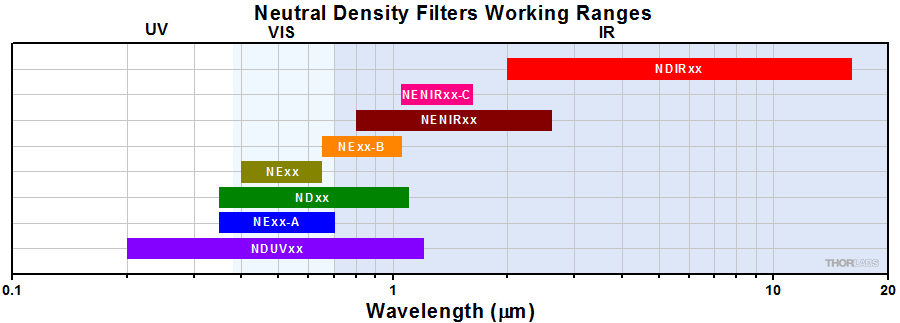
| Line On Graph | Wavelength Range | Type | Material | Coating | Mounting |
|---|---|---|---|---|---|
| NDIRxx | 2000 - 16,000 nm | Reflective | ZnSe | Inconel | Unmounted and Mounted |
| NENIRxx-C | 1050 - 1620 nm | Absorptive | Schott Glass | C-Coated | Unmounted and Mounted |
| NENIRxx | 800 - 2600 nm | Absorptive | Schott Glass | Uncoated | Unmounted |
| Mounted | |||||
| NExx-B | 650 - 1050 nm | Absorptive | Schott Glass | B-Coated | Unmounted |
| Mounted | |||||
| NExx | 400 - 650 nm | Absorptive | Schott Glass | Uncoated | Unmounted |
| Mounted | |||||
| NDxx | 350 - 1100 nm | Reflective | N-BK7 | Inconel | Unmounted |
| Mounted | |||||
| NExx-A | 350 - 700 nm | Absorptive | Schott Glass | A-Coated | Unmounted |
| Mounted | |||||
| NDUVxx | 200 - 1200 nm | Reflective | UVFS | Inconel | Unmounted |
| Mounted |

*At 633 nm
| Item # | Optical Density* (Transmission) |
Transmission Data |
|---|---|---|
| NE510B | 1.0 (10%) | |
| NE513B | 1.3 (5%) | |
| NE515B | 1.5 (3%) | |
| NE520B | 2.0 (1%) | |
| NE530B | 3.0 (0.1%) | |
| NE540B | 4.0 (0.01%) | |
| NE550B | 5.0 (1x10-3%) | |
| NE560B | 6.0 (1x10-4%) |
Click on ![]() for a plot and downloadable data. The black dashed line indicates the designated optical density.
for a plot and downloadable data. The black dashed line indicates the designated optical density.

*At 633 nm
Click on ![]() for a plot and downloadable data. The black dashed line indicates the designated optical density.
for a plot and downloadable data. The black dashed line indicates the designated optical density.


*At 633 nm
| Item # | Optical Density* (Transmission) |
Transmission Data |
|---|---|---|
| NE210B | 1.0 (10%) | |
| NE213B | 1.3 (5%) | |
| NE215B | 1.5 (3%) | |
| NE220B | 2.0 (1%) | |
| NE230B | 3.0 (0.1%) | |
| NE240B | 4.0 (0.01%) | |
| NE250B | 5.0 (1x10-3%) | |
| NE260B | 6.0 (1x10-4%) |
Click on ![]() for a plot and downloadable data. The black dashed line indicates the designated optical density.
for a plot and downloadable data. The black dashed line indicates the designated optical density.

- Comprehensive Set of Absorptive ND Filters
- 400 - 650 nm Wavelength Range; For Performance at ≥650 nm, See Specs (Absorptive) Tab
- Ø1/2" (Ø12.7 mm), Ø25 mm (Ø0.98"), Ø2" (Ø50.8 mm), and 2" x 2" (50.8 x 50.8 mm) Versions
- Round Filters Provided in SM-Threaded Mounts Engraved with OD and Part Number
- Filters Also Available with OD 6, 7, and 8 (Sold Separately; See Links Below)
- Additional NBK-7 Mounted Absorptive and Unmounted Absorptive Filters Available
| Item # | Optic Size |
Mount | Included Storage Box | Included Optical Densities |
|---|---|---|---|---|
| NEK02 | Ø1/2" | SM05 | KT02 | 0.1, 0.2, 0.3, 0.4, 0.5, 0.6, 1.0, 1.3, 2.0, 3.0, 4.0, 5.0 |
| NEK01 | Ø25 mm | SM1 | KT01 | 0.1, 0.2, 0.3, 0.4, 0.5, 0.6, 1.0, 2.0, 3.0, 4.0 |
| NEK03 | Ø2" | SM2 | KT06 | 0.1, 0.2, 0.3, 0.4, 0.5, 0.6, 1.0, 2.0, 3.0, 4.0 |
| NEK01S | 2" x 2" | - | KT03 | 0.1, 0.2, 0.3, 0.4, 0.5, 0.6, 1.0, 2.0, 3.0, 4.0 |
 Products Home
Products Home














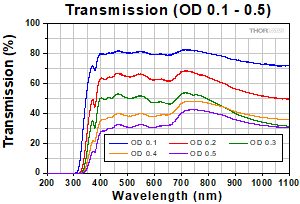
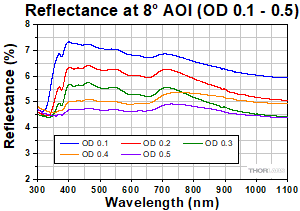
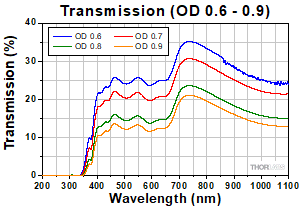
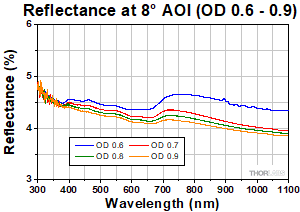
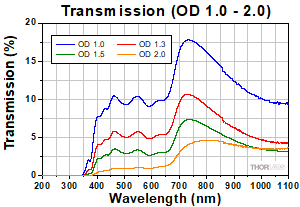
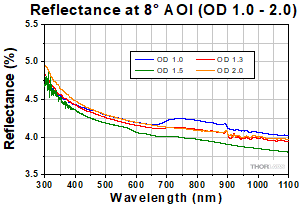
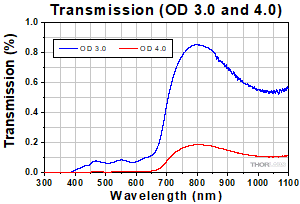
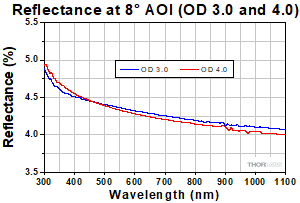
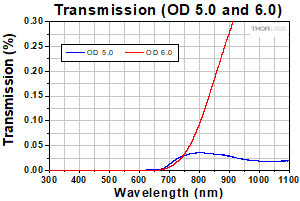
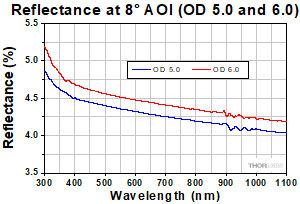
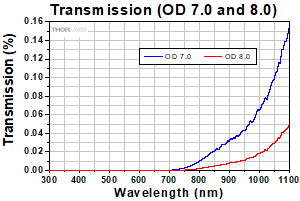
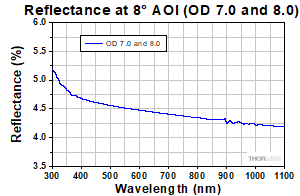

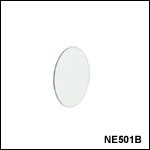
 Zoom
Zoom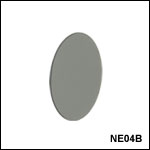
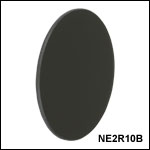
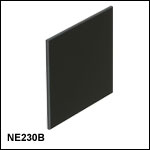
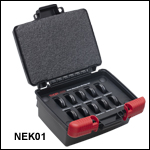
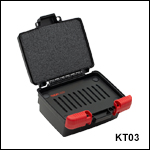
 Unmounted Absorptive ND Filters (Schott Glass)
Unmounted Absorptive ND Filters (Schott Glass)